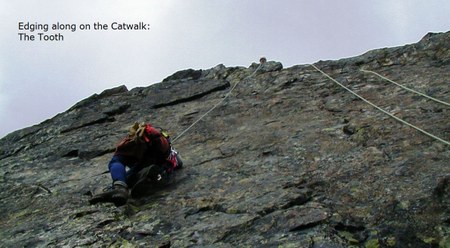
[LEADER]
A rope leader (Intermediate Student) climbed the catwalk to the summit. Upon arriving he asked me (the leader) what to use for an anchor and was indicating a flake was going to be his preference. I told him not to use it as you could not safely get a cordelette completely around it and pointed out two cracks to use with gear instead.
Upon returning moments later I arrived just as he was "testing" his anchor by fully throwing his body weight on the cordelette he had put around the flake I told him not to use. It immediately started to fail causing him to stumble back to the edge of the ledge he was on (the cordelette started slipping rapidly off the flake) and I grabbed the cordelette to prevent it from completely coming off.
The rope leader still thought his anchor was good and said he was fine (he was still leaning backwards almost off the ledge). I shouted at him to stop and again remarked that his anchor was not safe, so he moved back into balance and away from the ledge. I showed him how his anchor had literally came one foot from completely sliding off the flake and pointed out that had it failed he would have hit the ledge below him and then rolled over the edge falling down the 400' face past the cat walk.
He did not believe he would have rolled off the edge, but did acknowledge his anchor was inadequate and created a new one as I had originally directed him to do.
[Rope Leader]
I'm afraid I gave the leader quite a fright, and I am really very sorry for that. He turned to me just as I was testing cordelette slung around a big snag. I leaned back on the anchor, and the cordelette began to move, so I stepped quickly back toward the snag. From the leader's perspective, I'm certain it must have looked like I was about to go right over the edge.
I did use a portion of my body weight to test the anchor, but in my judgment the location would not have resulted in a significant fall. I was standing on a ledge with about four feet below me to a more-or-less flat (to slightly sloping) run out with approximately ten to fifteen feet to the next down section. Even so, having the cordelette move unexpectedly gave me a very clear lesson in anchor redundancy.
Additionally, and more fundamentally, I should have built a better anchor to begin with! My judgment that the cordelette would remain fixed in place around the large snag proved incorrect, and when I leaned back on it, the cordelette began to ride up the snag
[Seattle Safety Officer]
Do you have any thoughts about “anchor testing with body weight” that others might benefit from?
[Rope Leader]
Absolutely. First, clip into your first piece of protection with a personal anchor. Second, build a SERENE anchor. Third, test the anchor in a safe location where any failure will not result in a fall. With 20/20 hindsight the anchor I was testing was not SERENE.
(1) Solid: NOT (I thought the cordelette was very secure at the base of the snag, and did not expect it to move . . . that's why redundancy is so important)
(2) Efficient: YES (probably too efficient)
(3) Redundant: NOT (the cordelette needed to be backed up with something else regardless of how secure I thought it to be)
(4) Equalized: YES
(5) No Extension: YES
[Seattle Safety Officer]
What would you suggest to other Intermediates if asked about setting up an anchor on the summit of the Tooth?
[Rope Leader]
Once at the top, even though it is flat with plenty of room for walking around, don't let your guard down. Find a place to build a SERENE anchor and finish in excellent form.
[Mountaineer Safety Committee Member]
This report describes what happened at the same place many years ago, except that the tester fell some 90 feet and lost all spinal cord function below his waist when caught by the rope. Previously he had been one of the most Club's most talented young up-and-coming rock climbers. Completely disabled from the waist down, he wheel-chaired himself in to Intermediate course lectures for years thereafter to advocate safe anchoring practices. We apparently have lost the institutional memory of such accidents, and need to spread the word again.
 David Shema
David Shema